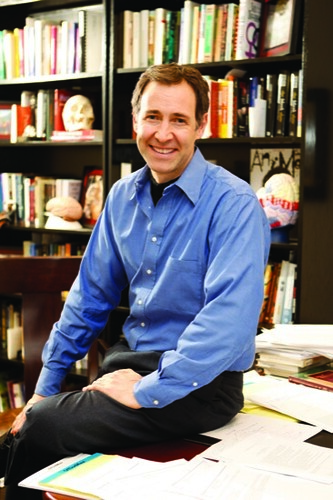
A childhood fascination with animal behavior led Owen Jones on a path to becoming one of the country’s foremost experts in the field of law and behavioral biology. Today he is one among a handful of academics in the country holding faculty appointments in law and biology and conducting significant research in both fields.
“Everything law does depends on some model of human behavior,” says Jones, professor of law and professor of biological sciences. “And yet our models of human behavior are fairly incomplete and lack a robustness that could be increased by adding insights about behavior that flow from biology.”
A consideration of biological factors does not mean “my brain made me do it” becomes a handy legal defense–any more than the height of a child’s parents predicts with absolute certainty how tall that child will be in adulthood. “Biology makes understanding human behavior more complex, rather than more simple,” Jones explains. “Behavior doesn’t come prepackaged in either environmentally influenced or genetically determined potentiality. These things intersect, and they intersect in complex ways that are biologically and evolutionarily influenced.”
“Behavior doesn’t come prepackaged in either environmentally influenced or genetically determined potentiality. These things intersect, and they intersect in complex ways that are biologically and evolutionarily influenced.”
~ Owen Jones
The intersection of biology and behavior has been of interest to Jones as long as he can remember. A great collector of books on the subject of animal biology, he was also a keen observer of animals and their behavior.
“As a child I remember a mockingbird that used to jump up and display at larger birds, like crows. But I also noticed that it displayed to distant airplanes, of the same apparent size as the nearer birds,” says Jones. “This was a conflict between a behavior that would ordinarily work very well for the bird and a behavior now bumping up against a novel environmental feature–an airplane–that results in a waste of time and energy.”
Building on his early interest in biology and behavior, Jones used his undergraduate and law school years to combine a passion for science with an equally intense interest in making the legal system as efficient and effective as possible. As an undergraduate at Amherst College, Jones diversified his interests rather than limiting his focus to animal behavior. The exposure to policy analysis and academic research as well as laboratory work led to his study at the intersection of law and biology and to Yale Law School.
Determined to enter the legal academic market, he completed a judicial clerkship, several years of work with a well-known law firm in Washington, D.C., and published a number of papers in academic journals. His work paid off, and he was offered a position at Arizona State University, home to the oldest program in law, science and technology in the country. Though he was initially appointed to the law school faculty there, his interest and work in biology also earned him a tenured position in biology.

Rather than relying solely on the disciplines traditionally consulted for answers by legal policymakers in the last few decades–psychology, sociology, economics, philosophy–Jones believes the fields of evolutionary biology and neuroscience can provide new, more scientifically sound perspectives.
His research attempts to answer questions related to legal efficiency by asking–through a joint legal and neuroscience lens–how the tools of law could be used to help people behave more like they should and less like they shouldn’t. What sort of environmental changes could the legal system encourage, in light of what is becoming known about the brain, that could lead to positive changes in human behaviors? How could law be used to better help people overcome their own evolutionally, neurologically influenced irrational behaviors?
“The more you can understand about how and why the brain prompts us to behave the way we do, the better equipped you are to understand the resulting behavior–and to think about ways to effectively and efficiently guide the behavior towards constructive outcomes,” says Jones.
The study of that point where law and science intersect is not particularly new. Forensics testing, expert testimony from psychologists and physicians, and federal regulations regarding genetically modified foods are all examples of ways in which science and its findings are intertwined with the legal system.
Even within behavioral biology, however, neuroscience is a newer addition to the law and science mix. It is within this specific realm that Owen Jones now works and studies. What happens here does not attempt to overlay scientific knowledge onto the existing legal system, but instead calls for a careful examination of how people’s biological capacities interact with our current system of laws and punishments.
During the past year this intersection of law and neuroscience has attracted more widespread attention. A New York Times Magazine cover story (March 11, 2007) exploring how neuroscience might transform the legal system prominently featured the work of Jones, his many Vanderbilt colleagues, and the world-class imaging institute led by John Gore. More recently, the field made news when the John D. and Catherine T. MacArthur Foundation announced a $10 million grant to fund the national Law and Neuroscience Project. Jones was tapped to co-direct one of three areas of study within the project.
Jones’ team is interested in risk assessment and its role in criminal behavior: What is the chance I’ll get caught? What is the chance I’ll be punished? What might my punishment be? Is the punishment I might receive worth what I might gain if I commit the crime?
Through the Law and Neuroscience Project, more than 30 researchers at nearly two dozen universities around the country are divided into three networks dedicated to exploring topics of addiction, brain abnormalities and decision making as they relate to the law. Jones will help lead the decision-making network, which includes Vanderbilt collaborators René Marois, associate professor of psychology and neuroscience; Jeffrey Schall, E. Bronson Ingram Professor of Neuroscience, director of the Center for Integrative and Cognitive Neuroscience, and director of the Vanderbilt Vision Research Center; and Erin O’Hara, professor of law and director of Vanderbilt Law School’s Law and Human Behavior Program.
Jones and colleagues’ team will examine how and why choices are made related to breaking laws. They are particularly interested in risk assessment and its role in deciding whether to engage in criminal behavior: What is the chance I’ll get caught? What is the chance I’ll be punished? What might my punishment be? Is the punishment I might receive worth what I might gain if I commit the crime?
Using functional magnetic resonance imaging (fMRI) scanners, their work will also examine the neuroscience of decision making as it relates to determining guilt versus innocence and severity of punishment.
Jones’ highly collaborative work relies on the availability and interest of colleagues from the Law School, the College of Arts and Science, the Medical School, and the Vanderbilt Institute of Imaging Science. The prospect of working on projects such as the one funded by the MacArthur Foundation brought Jones to Vanderbilt, where he credits a collegial and collaborative atmosphere for making traditional academic boundaries almost arbitrary.
“Disciplines should be linked so that a problem, rather than a subject area, is truly at the forefront,” he says. “You can walk into another department at Vanderbilt and talk to colleagues and get them excited about the prospects of collaboration. That’s not true everywhere. Being transinstitutional enables the university to be academically nimble in making new discoveries. We are doing exciting theoretical work as well as empirical work here that simply isn’t being done elsewhere.”
That emphasis on collaboration spills over to Jones’ teaching. Last semester he partnered in the classroom with neuroscientist Schall, offering a course in law and neuroscience that enrolled 35 students from graduate programs in law, psychology and neuroscience. Like their teachers, the students worked together on interdisciplinary projects, with the goal of designing new neuroscience research that could be executed at the intersection of law and neuroscience.
“This was an opportunity to get graduate students in neuroscience and psychology in the same room with law students, and it was the first time here we offered a course like this,” says Schall. “It was very exciting, and there was tremendous energy and enthusiasm.”
The course allowed third-year law student Anna Henderson to gain exposure to the field of neuroscience within the context of her own academic work. “I call Professor Jones a true teacher because he loves engaging with students,” says Henderson. “His favorite thing seems to be stimulating young minds–in conversations, in the classroom. He’s attuned to detail and quality work from himself and in drawing it out of his students. He makes you do better work.”
As to potential effects of his research on decision making, risk assessment and the legal system, Jones takes a long view. “Right now my colleagues and I are mainly trying to generate sufficient momentum in the legal academy so that some of the thinking will roll over into aspects of legal policymaking,” he says. “This is ultimately about how we use the tools of law to shape the environments in which people behave.”
He is encouraged by what he sees as the growing exploration of the field of law and neuroscience. Ten years ago he founded a scholarly association dedicated to interests in the intersection of law and biology. Today the Society for Evolutionary Analysis in Law (SEAL) has more than 400 members from 24 countries. They include legal thinkers, economists, philosophers and biologists. The number of articles written on the subject of law and behavioral biology grows each year. Articles in other fields citing these papers also have increased in number. All of this–including popular media coverage by such publications as The New York Times and the recognition that comes from securing the MacArthur Foundation grant–contributes to a growing academic and public awareness about the field of study for which Jones is so passionate.
“The brain is not a black box but a highly developed, highly algorithmic, evolved, condition-dependent, environmentally sensitive information processor that is designed to skew the probabilities of certain behavioral outputs given certain kinds of behavioral inputs,” says Jones. “Any explicit recognition that all behavior of interest to law comes from the brain, I think, will move us in the direction of increasing the efficiency and effectiveness of certain areas of law.” V